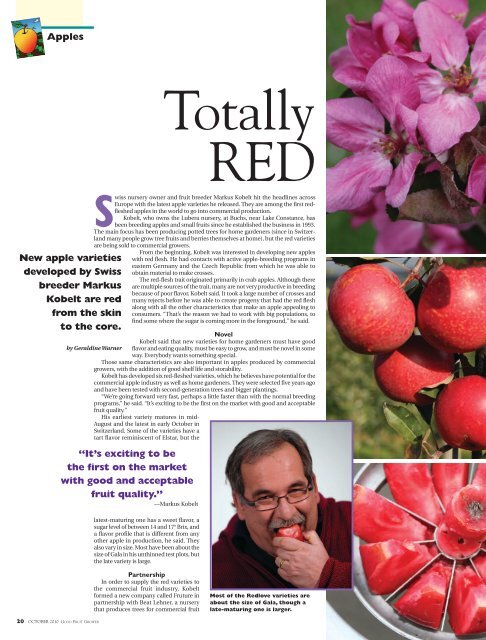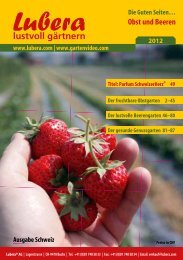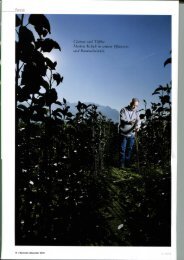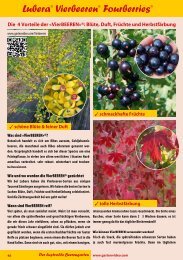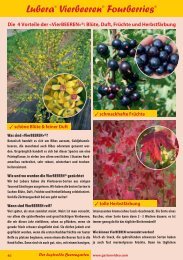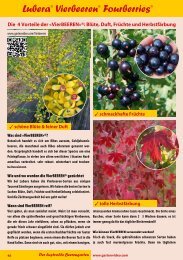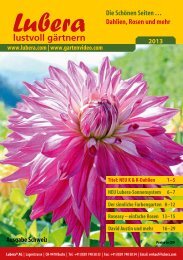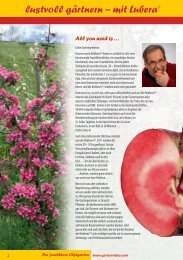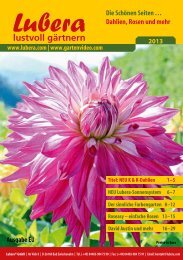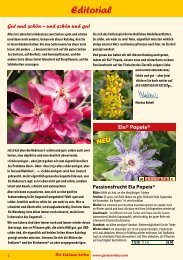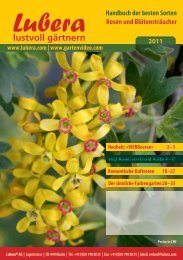New apple varieties developed by Swiss breeder Markus ... - Lubera
New apple varieties developed by Swiss breeder Markus ... - Lubera
New apple varieties developed by Swiss breeder Markus ... - Lubera
- No tags were found...
Create successful ePaper yourself
Turn your PDF publications into a flip-book with our unique Google optimized e-Paper software.
For more information and videos ofRedlove <strong>apple</strong>s, check the Web siteat www.lubera.co.uk.PHOTOS BY MARKUS KOBELTgrowers, and <strong>Swiss</strong> <strong>apple</strong> grower ThomasHungerbühler.Then, Fruture formed a joint venturewith the Next Fruit Generation (NFG)Group in the Netherlands to market thered <strong>varieties</strong> internationally. All the red<strong>varieties</strong> will be marketed under theRedlove brand name, rather than <strong>by</strong> theirpatented variety names. Kobelt said theyall look similar from the outside, with full red skin, but the differentripening times will provide an extended marketing season.He doesn’t think growers in a particular growing region willgrow all six.Goldland Fruit Group in China’s Hebei Province has alicense from NFG to propagate Redlove trees and developproduction in China. It exhibited fruit at the 2009 Asia FruitLogistica trade fair in Hong Kong.IN THE pipeline…Top: Trees withred-fleshed <strong>apple</strong>sgenerally have brightpink blossoms.Center and top right:<strong>Markus</strong> Kolbert has<strong>developed</strong> six redfleshed<strong>varieties</strong> witha range of ripeningtimes that will all bemarketed under theRedlove name.Other efforts to develop red-fleshed <strong>apple</strong> <strong>varieties</strong> are goingon around the world.In <strong>New</strong> Zealand, fruit <strong>breeder</strong>s have been working todevelop red <strong>varieties</strong> since 1998. Scientists at the Institute for Plantand Food Research Limited (formerly HortResearch) have pinpointedthe gene that controls the anthocyanins, which are the redpigments, and have <strong>developed</strong> genetic markers to quickly identifyseedlings with red fruit without needing to grow the trees.Varieties <strong>developed</strong> in <strong>New</strong> Zealand will be commercializedthrough the international company Prevar. Lynnell Brandt, presidentof Brandt’s Fruit Trees, Inc., Yakima, Washington, which is ashareholder in Prevar, said red-fleshed <strong>apple</strong>s are a primary focusof the <strong>New</strong> Zealand breeding program, but scientists are still workingto find selections with superior eating quality. He expects tohave red selections to test in the next two years.GermanyA red variety called Weirouge, a chance seedling found in Germany,is being grown commercially in Europe but is not suitable forfresh consumption, according to Dr. Walter Guerra at the LaimburgResearch Center for Agriculture and Forestry in the South Tyrolregion of Italy.Guerra said the variety, which is fully red from the flowers to theleaves to the flesh, has been tested in the South Tyrol for severalyears but seems only to have potential for processing. It is astringent,mealy, susceptible to scald, and lacks good flavor.Karl Luggin, a grower in the Vinschgau Valley in the South Tyrol,began planting the variety a few years ago and makes innovativeprocessed products from it, such as juice, <strong>apple</strong> wine, and driedfruit (www.luggin.net/weirouge.html). —G. WarnerBecause the red pigments areantioxidants, red-fleshed <strong>apple</strong>sdo not turn brown when sliced.Big newsWhen Suttons, a large nursery in the United Kingdom,signed up to supply Redlove trees to English gardeners, itwas big news in the British media.“Normally, if you introduce a new <strong>apple</strong>, you have nochance to come into The Times or the Daily Mail, but withthis story, it’s very easy,” said Kobelt, who was also interviewed <strong>by</strong> the BBC(British Broadcasting Company).The first question the media asked was whether the <strong>apple</strong>s were <strong>developed</strong> through genetic modification.He explained that they were <strong>developed</strong> through traditional breeding techniques, which he seesas a marketing advantage in Europe.Each year, he plants about 10,000 to 20,000 seeds from crosses in pots in the greenhouse. When theseedlings have two or three leaves, he inoculates them with the scab organism to find which survive andare therefore resistant. He can get a good idea of which will produce red fruit just <strong>by</strong> looking at the leaves.Generally, seedlings that have red leaveswill produce red fruit, with a few exceptions.Red-fleshed <strong>apple</strong>s usually havebright pink blossoms instead of white.When the seedlings are about twometers (six feet) tall and have beenscreened for scab resistance and color, thetops are grafted onto Malling 9 or 27 rootstocksand planted out in the field forfurther evaluation.First plantingsThis fall, the first 60,000 to 100,000Redlove trees will be planted in commercialorchards in Switzerland, Italy, France,and possibly England. Kobelt said growersare starting slowly because marketdemand is unknown.“Nobody on the marketing side knowsif there’s a market niche for 2 percent ofthe market or 20 percent of the market,”he said.Fruit should be in the retail stores inabout five years. Kobelt sees an opportunityto create excitement in the marketplacewith this new and exotic productthat might appeal even to people who arenot normally <strong>apple</strong> eaters. Because anthocyaninsare antioxidants, the <strong>apple</strong>s couldbe promoted as being exceptionally goodfor the health, similar to other red fruits.The antioxidants also prevent the fleshfrom turning brown when sliced.He thinks supermarkets will be eager tosell the <strong>apple</strong>s because they like to haveproducts that their competitors don’thave. However, they might also be a little afraid becausethis will be the first time they sell an <strong>apple</strong> that they needto promote to the consumers. “It’s a new product that’sreally different,” he said. •“Nobody knows ifthere’s a marketniche for 2 percentof the market or20 percent ofthe market.”—<strong>Markus</strong> Kobeltwww.goodfruit.com GOOD FRUIT GROWER OCTOBER 2010 21


